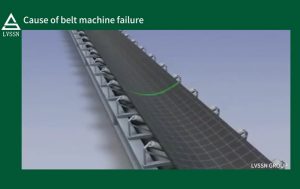Overview: Conveyor belts (also known as belt conveyors) are widely used in industrial production, but various issues can arise during their operation. Common conveyor belt problems and their causes include:
Cause of belt machine failure
2023-07-22 11:23:59
 Overview: Conveyor belts (also known as belt conveyors) are widely used in industrial production, but various issues can arise during their operation. Common conveyor belt problems and their causes include:
1. Belt Misalignment:
- Improper Installation: Misaligned pulleys or drums cause the belt to run off-track.
- Uneven Belt Tension: Uneven tension can lead to belt misalignment.
- Uneven Load Distribution: Uneven distribution of material on the belt creates imbalance.
2. Belt Slippage:
- Insufficient Tension: Lack of adequate belt tension causes slippage.
- Belt Wear: Worn belt surfaces reduce friction, leading to slippage.
- Slippery Pulley Surface: Smooth or oily pulley surfaces can cause the belt to slip.
3. Belt Breakage:
- Overloading: Prolonged overloading leads to excessive fatigue and breakage.
- Belt Aging: Material aging reduces the belt's strength.
- Foreign Object Damage: Sharp or hard objects can damage the belt.
4. Pulley or Roller Malfunction:
- Bearing Failure: Lack of lubrication or worn bearings prevent pulleys or rollers from rotating properly.
- Jammed Rollers: Jammed rollers can cause excessive belt wear.
5. Motor or Gearbox Issues:
- Overload: Prolonged overloading causes the motor or gearbox to overheat or burn out.
- Poor Lubrication: Insufficient or degraded lubrication accelerates gear wear.
6. Material Accumulation:
- Poor Discharge: Material accumulation at discharge points increases the belt load.
- Material Spillage: Spillage along the belt sides or bottom increases wear.
7. Environmental Factors:
- Extreme Temperatures: Very high or low temperatures affect belt elasticity and strength.
- Humidity and Chemical Corrosion: High humidity or corrosive environments accelerate belt and equipment aging.
Summary:To prevent conveyor belt problems, regular inspections and maintenance are essential. This includes adjusting belt tension, removing foreign objects, lubricating bearings and pulleys, and checking motor and gearbox conditions. Additionally, using the equipment properly and avoiding overloading can effectively reduce the occurrence of faults.
Disclaimer
Overview: Conveyor belts (also known as belt conveyors) are widely used in industrial production, but various issues can arise during their operation. Common conveyor belt problems and their causes include:
1. Belt Misalignment:
- Improper Installation: Misaligned pulleys or drums cause the belt to run off-track.
- Uneven Belt Tension: Uneven tension can lead to belt misalignment.
- Uneven Load Distribution: Uneven distribution of material on the belt creates imbalance.
2. Belt Slippage:
- Insufficient Tension: Lack of adequate belt tension causes slippage.
- Belt Wear: Worn belt surfaces reduce friction, leading to slippage.
- Slippery Pulley Surface: Smooth or oily pulley surfaces can cause the belt to slip.
3. Belt Breakage:
- Overloading: Prolonged overloading leads to excessive fatigue and breakage.
- Belt Aging: Material aging reduces the belt's strength.
- Foreign Object Damage: Sharp or hard objects can damage the belt.
4. Pulley or Roller Malfunction:
- Bearing Failure: Lack of lubrication or worn bearings prevent pulleys or rollers from rotating properly.
- Jammed Rollers: Jammed rollers can cause excessive belt wear.
5. Motor or Gearbox Issues:
- Overload: Prolonged overloading causes the motor or gearbox to overheat or burn out.
- Poor Lubrication: Insufficient or degraded lubrication accelerates gear wear.
6. Material Accumulation:
- Poor Discharge: Material accumulation at discharge points increases the belt load.
- Material Spillage: Spillage along the belt sides or bottom increases wear.
7. Environmental Factors:
- Extreme Temperatures: Very high or low temperatures affect belt elasticity and strength.
- Humidity and Chemical Corrosion: High humidity or corrosive environments accelerate belt and equipment aging.
Summary:To prevent conveyor belt problems, regular inspections and maintenance are essential. This includes adjusting belt tension, removing foreign objects, lubricating bearings and pulleys, and checking motor and gearbox conditions. Additionally, using the equipment properly and avoiding overloading can effectively reduce the occurrence of faults.
Disclaimer
Some of the articles, graphics, and videos reproduced on this website (www.Ivssn.com) are sourced from the internet. The copyright and responsibility belong to the original authors. The reposting on this website is aimed at disseminating more information to everyone and does not represent the views of this website. If you have any objections to the content reposted on this website or if there are any copyright issues involved, please contact us as soon as possible, and we will promptly take appropriate measures to address them.
Previous
Next
View List
